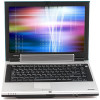Toshiba Satellite M55-S325 Toshiba Online Users Guide for Satellite M50/M55 - Page 199
Wireless device problems
 |
View all Toshiba Satellite M55-S325 manuals
Add to My Manuals
Save this manual to your list of manuals |
Page 199 highlights
199 If Something Goes Wrong Resolving a hardware conflict Wireless device problems NOTE This section provides general troubleshooting tips for networking problems, specifically wireless (Wi-Fi) networking. The terms and concepts used assume a basic understanding of networks, and may be for more advanced users. If you need assistance or if you are not familiar with the terminology, please see Windows Help and Support or contact your computer technician. ❖ If your computer is equipped with an internal Wi-Fi adapter, verify that the Wi-Fi antenna switch is on (the right-most light on the system indicator panel will be lit.) NOTE To determine if your computer has an internal Wi-Fi adapter, check the device list in Device Manager (part of the Windows Control Panel). Some Toshiba models may have a Wi-Fi antenna switch even though they do not have an internal Wi-Fi adapter. ❖ Verify that signal strength is good using the utility provided with the Wi-Fi adapter. ❖ If another computer is on the same network, verify that it has network access, and can connect to the Internet. If, for example, the other computer cannot browse to a public website, the ISP's (Internet Service Provider) service may be disrupted. ❖ Verify that the Service Set Identifier (SSID), or network name, is correct-i.e., that it matches the SSID assigned to the access point you are attempting to connect through. SSIDs are case-sensitive. Toshiba provides a Client Manager utility for setting and managing SSIDs.















